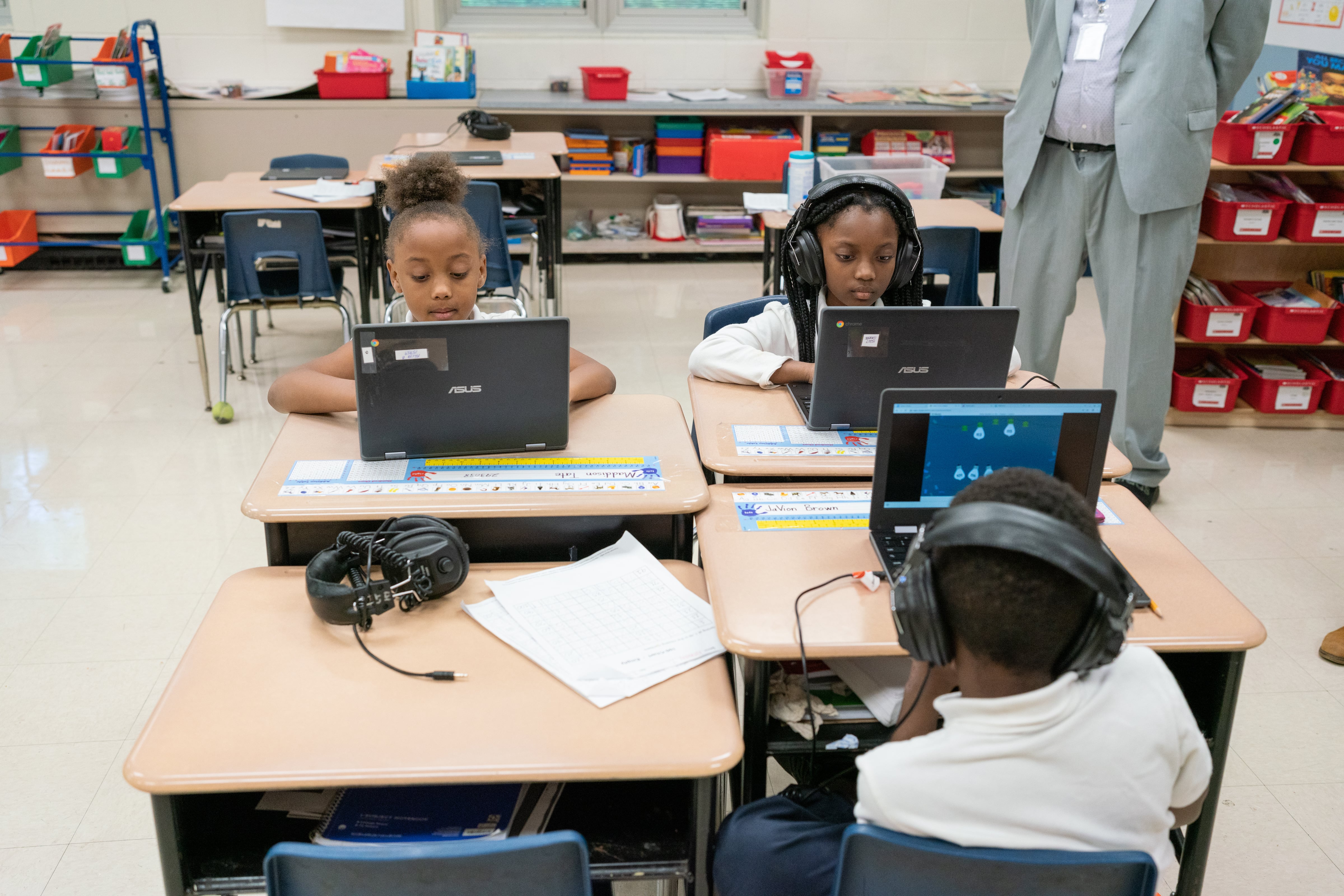One in three Illinois students missed at least a month’s worth of school last year.
English teacher Briana Morales is not surprised. She notices her high school students in East St. Louis 189 missing for weeks at a time. Many are working during school hours to support their families, lack access to transportation, or need child care but can’t afford it or find someone that they trust.
“I have a lot of students who have missed 40-plus days of school at this point in the school year,” Morales said.
Her district – where 100% of students come from low-income families — had one of the highest chronic absenteeism rates in Illinois last year at 69%.
Statewide chronic absenteeism climbed to almost 30% last year, after it shot up in 2021 to 21.2%, according to state report card data. A student is labeled chronically absent if they miss more than 10% of the school year — or about 18 to 20 days — with or without a valid excuse. Illinois defines the school year as a minimum of 185 days, with student attendance required for 176 days.
Chronic absenteeism is sometimes conflated with truancy. But Illinois defines truancy, which could lead to legal consequences for families, as a student missing about 5% of the school year without a valid excuse.
Missing school — with or without an excuse — impacts student learning, especially at a time when districts across the state are dealing with the academic fallout of the COVID-19 pandemic. National and state test scores have shown a significant decline in math and reading scores for students.
Chalkbeat Chicago’s analysis of state data found that 228 out of the state’s 852 school districts had a chronic absenteeism rate over the state’s average in 2022. Some had rates as high as 80%. Chicago Public Schools rate was almost 45%.
School districts with larger populations of students of color and students from low-income families had higher rates of chronic absenteeism, according to Illinois’ most recent report card data. The chronic absenteeism rate was 48% for Black students, 36% for Hispanic students, 43% for students from low-income families, 35% for English learners, and 40% for students with disabilities.
Illinois is not the only state seeing chronic absenteeism soar. Michigan’s rate in 2022 was 38.5% and Ohio’s rate was 30%.
Nationally, about one in five students was chronically absent during the 2020-21 school year, which means 10.1 million students were chronically absent, 2 million more than in 2019, according to an analysis by nonprofit Attendance Works and John Hopkins University.
National data for 2021-22 is not yet available, but Hedy Chang, executive director of Attendance Works, found that in some states chronic absenteeism rates have doubled this year. As the pandemic enters a new stage, Chang says schools will need to step up efforts to get students back in class.
“The high level suggests that it’s going to take a real intentional approach to help our kids fully recover and get back into school,” said Chang. “Make sure they feel confident about being in the classroom, given how much they’ve missed.”
Rockford students did not have a normal school year
Across Illinois, many schools were looking forward to a return to normal last school year after the state shuttered school buildings in 2020 and many schools continued remote or hybrid learning for the following school year. Principals, teachers, and students looked forward to seeing each other in person every day.
But getting students in classrooms regularly was harder than expected.
In Rockford School District 205, the state’s third largest district after Chicago and Elgin U-46, students struggled to get to class. The chronic absenteeism rate in the district rose to 61% last school year, up 26 percentage points from 2019 when it was 35.4%.
Morgan Gallagher, Rockford’s chief of schools, attributes the high chronic absenteeism rate to lack of transportation for students, a spike in COVID-19 cases, and students who transfer between schools within the district due to insecure housing that makes families move around a lot. About 45% of Rockford’s students are from low-income families.
Rockford, which serves almost 28,000 students across 44 schools, struggled to find bus drivers to transport 18,000 students at a time when districts across the state and country grappled with a national school bus driver shortage, Gallagher said.
The district provided additional bus service to schools with a higher chronic absenteeism rate to ensure that students who were more likely to miss school got there, he added. But the district still had to cancel routes for students for several months.
Gallagher also noted that it is harder to increase attendance for students who live 1.5 miles within their school’s walking distance because they are not eligible for bus transportation due to a state law.
When omicron hit schools across the state last winter, Rockford’s average daily attendance rate dropped from 82% to 72%. After the surge in COVID-19 cases eased during the spring semester, daily attendance went back up to 84%, but was still below pre-pandemic rates.
Another issue for Rockford is the district’s high student mobility rate — defined as the number of students who transfer between schools. Students who transfer outside of school multiple times throughout the school year or between school years are four times more likely to be chronically absent than students who do not change schools.
When a student transfers out of a school it doesn’t mean that they transfer out one day and start at a new school the next day — they often miss days in between the process, Gallagher explained. Many factors contribute to students transferring in and out of schools, including insecure housing, he noted. Families that have to move to find an affordable place to live often move outside the attendance boundaries for their schools, requiring students to transfer schools.
While Rockford struggled last year to get students back into classrooms, Gallagher says there are signs that this school year is better. Rockford has enough bus drivers and is trying to add more bus routes to support families that need transportation.
Gallagher believes that the chronic absenteeism rate should be lower on next year’s state report card because the district’s average daily attendance rate is 6% higher than last year.
Illinois dedicates money to bringing students back to classrooms
As the state and local school districts, such as Rockford, start to rebound from the COVID-19 pandemic, they are taking steps to encourage students to come to class every day.
The Illinois State Board of Education provided $12 million to the state’s 38 Regional Offices of Education and Intermediate Service Centers and Chicago Public Schools to hire more staff to connect with families through home visits and phone calls.
In Rockford, district officials have allocated $27 million to schools to use for any services that would help students in academics or with social-emotional support. Some schools have focused on chronic absenteeism and decided to hire attendance specialists who will reach out to students missing 18 or more days of school. Others hired parent and community liaisons who call and visit chronically absent students.
Schools are constantly looking at attendance because it plays a significant role in how students will do in school, Gallagher said.
“Attendance is the number one predictive factor related to a student being successful in school and ultimately getting to graduation,” he said. “The flip side of that is if you are chronically absent, the likelihood of you ultimately graduating with your high school diploma plummet.”
In Springfield SD 186, where about six out of 10 students were chronically absent last year, many students aren’t just missing classes for a day or two throughout the month, said high school English teacher Crysta Weitekamp. They often miss weeks of school and might show up one time and then miss another 10 days.
That puts them far behind their classmates. It also means more work for Weitekamp, who has to help those students catch up while making sure the rest of the class stays on track.
“As a teacher, I want the students here in my classroom. I want them to learn,” she said. “I want them in my classroom doing the work learning alongside everyone else, so they can be successful so they can graduate.”
Many of Weitekamp’s students are either working or babysitting kids in their families. About 56% of the district’s student population comes from low-income families.
Weitekamp’s school has hired a truancy interventionist, who works with both students who are chronically absent and truant, to contact families and students and do home visits to get students back into the classroom.
Morales, the East St. Louis teacher, is glad her district has partnered with an organization to provide therapy to students dealing with mental health crises that could be preventing them from going to school.
She said they also hired a truancy officer at each of the district’s 10 schools to make phone calls and home visits to help students who are missing school because of chronic absenteeism or truancy get back to class.
But Morales worries that one person won’t be able to track down every chronically absent student. There are just too many students missing too many days.
Samantha Smylie is the state education reporter for Chalkbeat Chicago, covering school districts across the state, legislation, special education, and the state board of education. Contact Samantha at ssmylie@chalkbeat.org.






